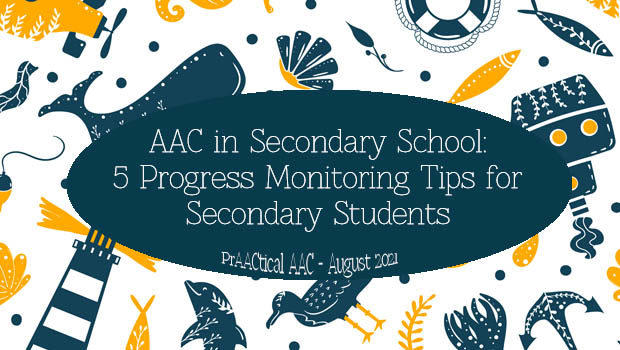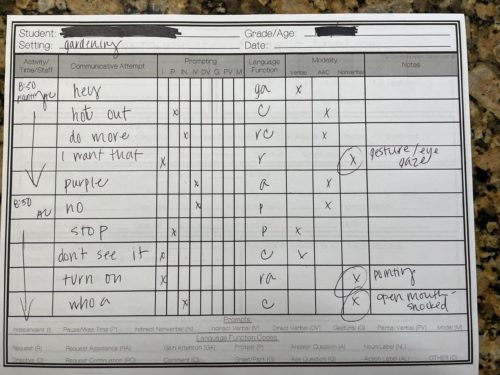AAC in Secondary School: 5 Progress Monitoring Tips for Secondary Students

 Looking for guidance or support regarding middle and high school students who use AAC? Today, we are pleased to welcome back AAC SLP Ashley Larisey for another post in the AAC in Secondary School series. Ashley is an SLP at Community High School District 218 in Oak Lawn, Illinois. She is also an Adjunct Clinical Supervisor and Instructor at Saint Xavier University.
Looking for guidance or support regarding middle and high school students who use AAC? Today, we are pleased to welcome back AAC SLP Ashley Larisey for another post in the AAC in Secondary School series. Ashley is an SLP at Community High School District 218 in Oak Lawn, Illinois. She is also an Adjunct Clinical Supervisor and Instructor at Saint Xavier University.
In today’s post, she shares thoughts on progress monitoring for high school students who are learning to use AAC.
You can view Ashley’s previous posts in this series here.
::::::::::::::::::::::::::::::::::::::::::::::::::::::::::::::::::::::::::::::::::::::::::::::::::::::::::::::::::::::
5 Progress Monitoring Tips for Secondary Students
Looking for guidance on meaningful progress monitoring for your high school/post-secondary students? Hopefully, these tips and accompanying resources will help guide you towards ensuring that your instruction is supporting your learner in reaching their communicative potential – beyond the formal educational years!
Writing Meaningful Goals
Ensuring that your progress monitoring is meaningful starts and is maintained through ongoing, dynamic assessment and goal writing.
Goals that aim to support learners in achieving autonomous communication are of significant importance. This handout (Linda Burkhart and Gayle Porter, 2019) provides a detailed overview of the goal writing process as well as key considerations, sample goals, and examples of language sampling. Three guiding principles are highlighted, which state that communication goals should:
- “Incorporate flexibility for the [learner] to say what they want to say when they want to say it
- Reflect increasing the ability of the [learner] to use a broad range of communicative functions
- Do not require the [learner] will have to communicate what someone else wants her to “say.” (Burkhart/Porter, From PODD communication books Advanced workshop manual © 2019)
Focus on the Goal, not the Tool
When learners aren’t making adequate progress towards a goal, it can be easy to blame the tool. While there certainly are times in which a certain tool may no longer meet the needs of the AAC user, it is also important to look at the overall goal and our implementation of that goal.

Augmentative and Alternative Communication Decisions quote, (Augmentative and Alternative Communication Decisions. (n.d.). Retrieved from https://www.asha.org/public/speech/disorders/communicationdecisions/)
Remembering that the goal of AAC is to support learners in expressing their own thoughts and own ideas can sometimes, inadvertently, result in hyper-focus on the use of the AAC system. It is important not to forget that ALL individuals communicate in a variety of different ways, and for a variety of different reasons. All methods of communication should be honored and valued. A goal specific to the use of an AAC system rather than the use of multi-modal communication (AAC, sign, gestures, verbalizations, eye gaze, etc.) may not be appropriate, as it does not value the communication message over the method of expression.
Involve Meaningful Communication Partners
Examining the communication partners within an AAC users circle of social networks can be particularly valuable when monitoring progress. Dr. Sarah Blackstone has completed extensive work in the area of social networks and has resources available here. Examining social networks can also be useful in identifying the different ways that individuals communicate within different circles, as well as circles in which individuals may need additional support with communication.
Relationships have been identified between the methods of expression used and the communication circle partner. AAC users often have individualized methods of communicating with life-long communication partners (e.g. gestures), in which the AAC system may not get used as frequently as it does with members of other circles (e.g. paid workers). However, if we are referencing the overall goal of effective and interactive communication, we may find that these are simply communicative differences, not areas where additional support is needed. Social networks also change drastically over the lifespan; as such, social networks should be evaluated over time. This presentation from Dr. Blackstone is an excellent overview of social networks.
Focus on Relevant Settings
Relevant settings are those that are naturally occurring to the learner. As students age, the number of relevant settings will likely increase and may include the following:
- Classrooms
- Community
- Vocational Opportunities
- Social Settings
- Home
- Shopping
- Transportation services

Completed Communication Sample Data Collection Form from Katelyn Kelps (@thecommunicationclassroom)
Keeping these settings in mind is critical when we are thinking about the generalization of skills. It is also important when we are examining the purposes of communication within these different environments. Performing skilled observations within relevant settings can reveal areas of strength as well as those where additional communication support may be beneficial. This communication sampling data form from Katelyn Kelps at The Communication Classroom is a great tool to use when completing skilled observations in different settings.
Use Language Sample Analysis
Once you have your communication sample, you can jump into language sample analysis to get a better picture of present levels. As mentioned previously – this may vary depending on communication partner and setting, so it is important to obtain communication samples across different people and environments.
The QUAD profile (Russell Cross) is a free tool available within AAC Language Lab that allows an evaluator to take information collected from language samples and compare them to four different checklists (vocabulary, morphology, syntax, function).
Additional information about language sampling and analysis is available in this post from PrAACtical AAC from Dr. Jill Senner and Matt Baud.
References
- Augmentative and Alternative Communication Decisions. (n.d.). Retrieved from https://www.asha.org/public/speech/disorders/communicationdecisions/)
- Blackstone, S. (2019). Social Networks Inventory [Powerpoint Slides]. ECHO voices. https://drive.google.com/file/d/1FEvPWsBeJH80_kGYt8Z5YthP2l0M-3_2/view
Filed under: Featured Posts, PrAACtical Thinking
This post was written by Carole Zangari
